How to Choose a Backpacking Tent
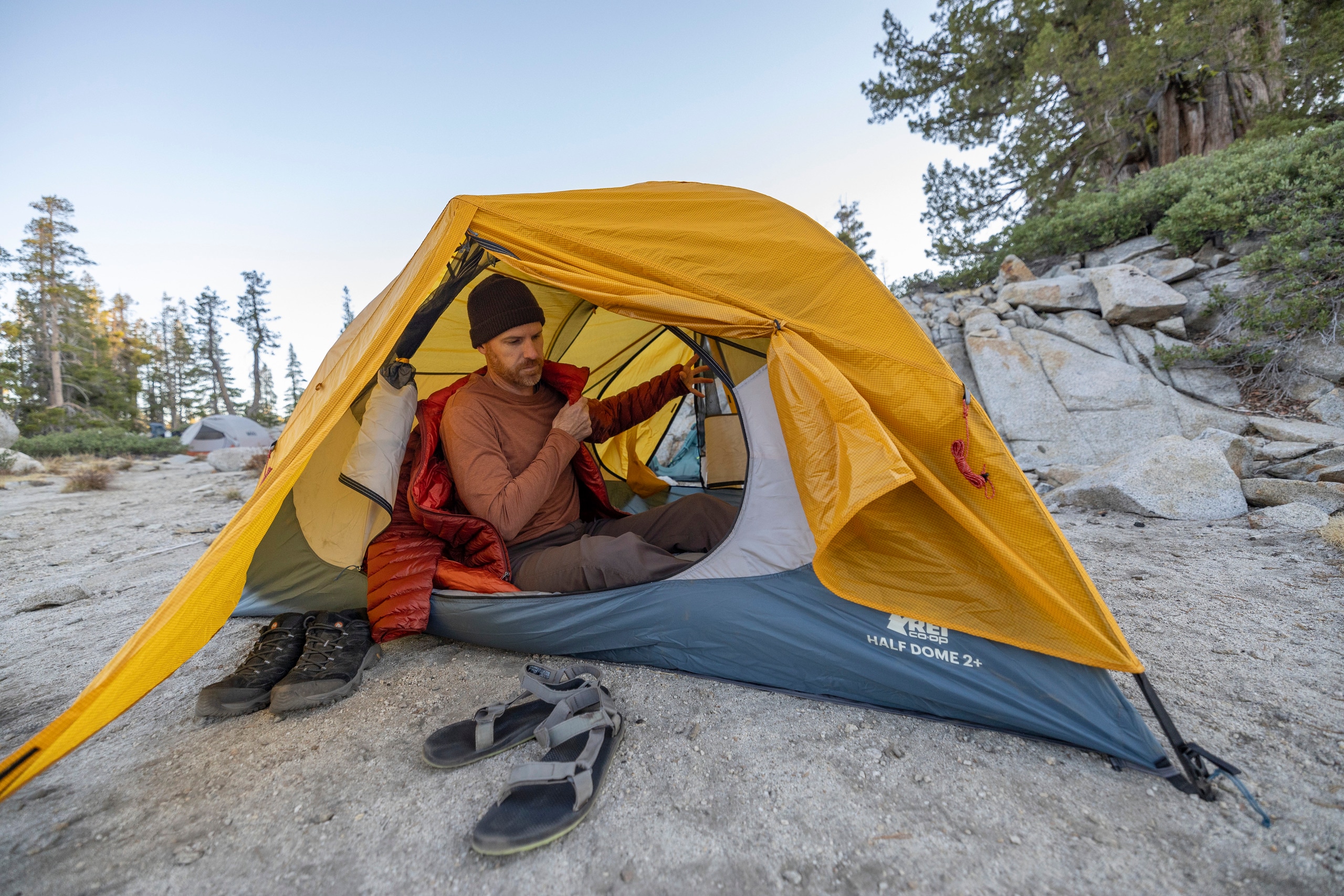
Ounce-counters, meet our lightest 2-person tent yet: the REI Co-op Flash Air 2. Pitch it with its own poles—or use your trekking poles instead to save weight—and you'll barely know it's in your pack.
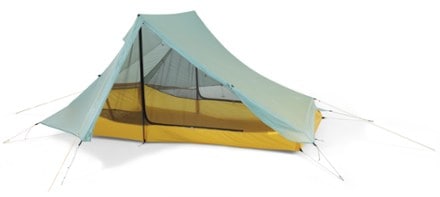


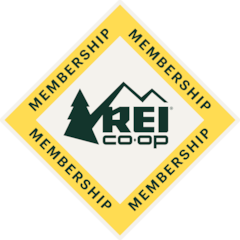
$38
10% Reward
on this and every eligible full-price item*
+
$30
Bonus Card
valid for 60 days after joining*
=
$68
Value
Keep shopping
Imported.
View the REI Co-op Flash Product LineView all REI Co-op Backpacking Tents| Best Use | Backpacking |
|---|---|
| Seasons | 3-season |
| Sleeping Capacity | 2-person |
| Minimum Trail Weight | 2 lbs. 6.5 oz. |
| Packaged Weight | 2 lbs. 13.65 oz. |
| Packed Size | 6.9 x 17.9 inches |
| Floor Dimensions | 88 x 52/42 (L x W head/foot) inches |
| Floor Area | 28.72 square feet |
| Vestibule Area | 21.18 square feet |
| Peak Height | 46.85 inches |
| Number of Doors | 2 doors |
| Number of Poles | 4 |
| Pole Material | DAC NFL aluminum |
| Canopy Fabric | 20-denier nylon mesh |
| Floor Fabric | 20-denier recycled ripstop nylon (bluesign® approved) |
| Rainfly Fabric | 20-denier recycled ripstop nylon (bluesign® approved) |
| Footprint Included | No |
| Ultralight | Yes |
| Design Type | Nonfreestanding |
| Sustainability | Contains recycled materials Contains materials that meet the bluesign® criteria From a Climate Label Certified brand |
From feedback to field testing, all of our gear is dialed-in by REI Co-op members. Their adventures informed every stitch and detail—making for better, longer-lasting gear.
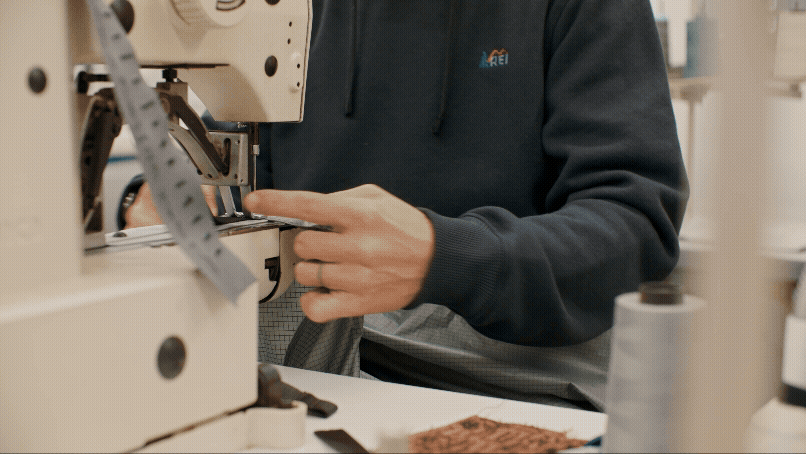
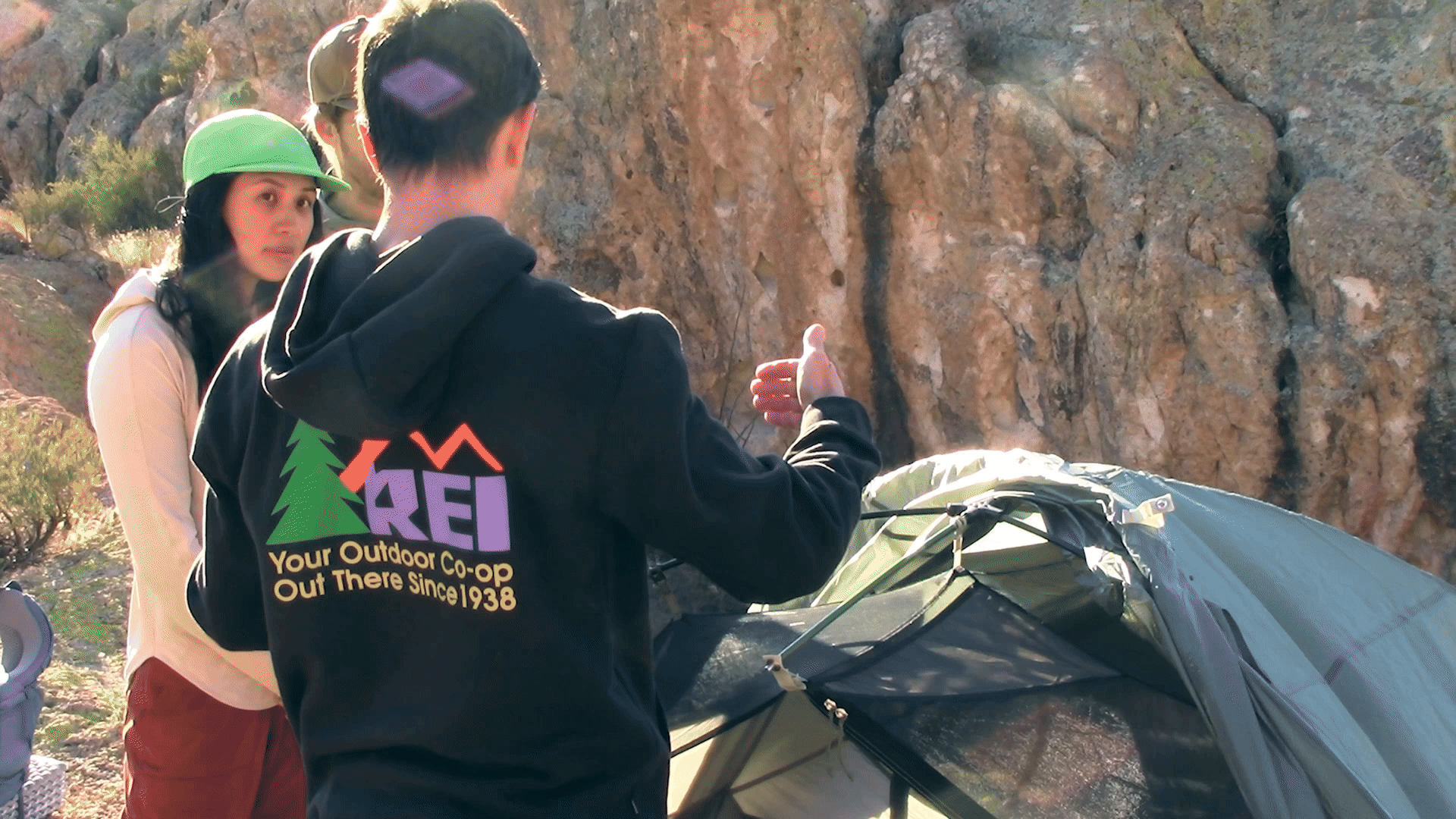
Adding a review will require a valid email for verification
When it comes to tents, I'm typically leaning toward something that I can stand up inside and have some room. When I camp on my own, I usually have a nice cot, a camp chair, and a small table inside my tent--that's how I do it. But I've always been curious about the ultralight world. Other than a small two-man tent from when I was a kid, I've never camped in anything that could be considered "ultra-light" by any stretch. So when REI offered to send me a free tent and ground cloth (Flash Air 2 Tent with matching Flash Air 2 footprint) in exchange for a thorough review, I was pleased to go through the experience and write it up to share with everyone. Upon arrival, the package arrived in very good order. The package was easy to open and the gear was in terrific shape. The very first thing I noticed: They have included real tent stakes! Not the cheapo bendy things that are usually included in a tent that is purchased off the shelf--some good tent stakes. They aren't my preferred stakes (which are the MSR Ground Hogs) but they are sturdy and strong, so I'm happy I don't have to replace them right away. I was disappointed in the font size of the instructions included--my eyes aren't what they used to be so it was difficult to get a good read on the initial instructions. And this brings me to my first suggestion: use both sides of the instruction page to print the instructions and double the font size. It will be easier to read and will not require more paper. The setup process is more complicated than most tents so clear instructions are important, especially for first-timers. The packed size was smaller than my regular two-person tent that I use for camping--the one I can stand up in, so I can see the savings for space when backpacking. But it was still larger than I expected it to be. I will say this: after I unrolled it in the house (you DO always check out your gear inside first before going outside, right?) I found that I could easily "stuff" the tent back in the bag without having to bother rolling it up. I hate rolling up tents. The "stuffing" approach usually calls to leave the tent poles and stakes out seperate, but I'm okay with that. There was PLENTY of room in the bag to put it back in if I want to take the time to roll it up. It's nice to know that the tent bag isn't going to just be used for shipping from the factory--it can stay with the tent through its lifetime use. The selection of online videos are weak--I can find only a few and they are not very instructional. It gets more complicated that the pictures on the REI website and the videos I could find don't match the tent--particularly, the photos and configuration include a "pole hub assembly" -- a black joint that connects the vertical standing pole to a horizontal pole across the roof. That part doesn't exist in the kit. I think the instructions online are working with trekking poles and the configuration I was sent includes two "long poles" that are clearly for support. It's possible that this is a re-design, so I may have to get creative in figuring out how to set this hot rod up. It's January where I live and nighttime gets below freezing but warms up some in the day. So the first available nice afternoon I have, I head outside and set up the tent. Following the process as best I can, I get it set up in what looks like a reasonable configuration. I use the included poles rather than trekking poles. With practice, I'm sure that I can get it "tighter" and "smoother" but it's enough to crawl inside and check it out. It takes longer than I had hoped and there are a lot of steps. Here's some of the outside features that I don't like: 1) A lot of support lines. I count 12 lines for this one tent. 2) I could actually use a couple more lines. That might seem in conflict with #1, but there are some points of "loose tent" that could be tightened with a properly-placed outside line. 3) The lines that are provided are much longer than necessary and force the tent to take up much more of a "service footprint" than should be required. It takes a lot of space to set the tent up for such a small tent. 4) The tent stakes--although better than standard cheapos, don't hold in the ground well. The soil is wet so that's some of it, but I will want to replace them with something that grips the soil better. 5) Ugly colors. Barf gray on top, faded orange on the bottom. Ew. Here's some outside features that I do like: 1) The tent material itself does seem to be durable, thin, and light. I like that a lot. 2) Two doors, one on each side. That's really nice. Time to crawl inside. Where's the zipper? There it is... oh, it only goes one way. The "feet side" of the tent has the zipper door, the "head side" netting is permanently sewn. Probably smart--no extra moving parts to break. Will take some getting used to... but I can appreciate the design. I'm inside and there is plenty of room for me to lay down, roll over, stow some gear, and sit up. I'm 5'9"/1.75m so I'll have more headroom than most, but there's room to spare for people taller than me. This is the "two-person" tent design, but I like having the extra width for storage and gear. Here's a really nice feature on the inside I like: the netted gear pockets are alongside the head area and are capable of holding a device such as a phone facing toward you so you can use the video feature while tucked into your sleeping bag: watch a movie, make a video call, you name it. There's room for phone, keys, small flashlight, and easily a few other items. Plus those pockets are on both sides of the tent. After about five minutes inside I realize that I'm starting to get colder than I should... okay, it's just a setup and not ready for overnight--I don't have a pad down, nothing like that... but I realize that even through my coat the ground is starting to suck heat out of my body. Then I feel a breeze coming over me. Yeah, the door is open, but the breeze didn't come from there. It came from my feet. And I look at my feet and there are nice, beautiful ventilation holes with netting over them on both sides. I glance at the head area and there are two more. I check the far sides and there's ventilation there too. This is a warm-weather tent. I check the REI website, it clearly says "3-season" -- okay then, not tonight. A 3-season tent is certainly not a bad thing! But it's January in the Kansas City area. We rarely have overnights above freezing so I'm starting to get concerned that I shouldn't really thoroughly test the tent for several months. Even if I had good winter-rated bedding, I still would get cold with the wide breeze coming from all angles. But I think on the right day, this would be okay. This is a little disappointing to me, because REI does want my comments within three weeks. But three weeks come and go, and every night has been below freezing. I can't test it overnight until it warms up. As I sit and think, I realize that if it was warm weather I could set up a hammock and rain fly in a few minutes with a lot less gear. But it is what it is. Some reviews mentioned that there is condensation buildup--that shouldn't happen in the cold, but it's not warm enough to test that so I can give no opinion. I can say that it would be really easy to set up a rapid ridgeline over the top and put an extra fly on top to protect it from the rain. That's something, right? Taking down the tent is straightforward and simple! The only difficulty is the "short poles" at the head and feet are very tight and hard to take out from the tent. I'm concerned that I'm going to either damage the pole or rip the tent-and that's never a good feeling. But once that's done, I easily stuff it quickly in the bag. That's my most favorite part: you can stuff it in the bag. Other than the time to take out the short head and feet poles, breaking down the tent is super-fast and easy. It DOES set up, it IS a tent, and I'm confident that on a summer day it would be breezy and I'd be happy. On a spring or fall day, I'd want to bundle up a little at night but I'm still certain it would be a nice evening. I'm unsure how it would perform in foul weather and I have low confidence in its ability to keep me warm during cold weather (which really is outside its designed purpose anyway). It's a three-season tent and I'm confident it will do its job under favorable conditions. On the downside, I could purchase four REI Co-op Groundbreaker 2 tents for the price of one of these. As a comparison, the Flash Air is lighter--a whole 2 pounds 5 ounces lighter. But is it $180 lighter? And the packed size isn't much smaller. I'm having a hard time coming up with a reason to recommend the product. SO: Will I keep the tent and use it? Yes. Am I glad to own it? Yes. Would I buy it? Probably not. But I think that response is more reflective of the type of camping I prefer to do rather than the product itself. What matters most to you is this question: should you buy it? The answer there is "maybe" -- and I mean that. If you are seeking a small 1-2 person ultralight tent this might be the one you want. It does its job, it performs as expected, and is certainly capable of delivering a good outdoor sleeping experience plus has room for gear. It is light, easy to take down, very easy to stuff back into its sack for hiking down the way, and is comfortable. I sure wouldn't talk anyone out of buying it! I would recommend you first make the decision on if you want to go with ultralight tent camping in the first place (compared to hammock camping or larger tents) and that will help you come to a better decision. But if you've made the decision to get an ultralight tent, consider this one. I'm looking forward to warmer days, I think I'm going to like it!
Flash Air 2 Review If you wanna reduce pack weight, you gotta be willing to sacrifice something and free standing tent might be one of them, but jump ahead without susplense, I’d say this 10 it’s worth every penny for my goals. Above all else - I’m trying to reduce Pak weight. With the Flash Air 2 (“FA2”) I’m going from 4-5 pound free standing Hubba Bubba to 2 1/2 pounds Therefore - I’m willing to spend extra time to stake this tent out correctly. Buy a couple extra steaks and some cord and then focus on hiking my remaining 125 miles on the long trail. The FA2 is also on sale. It’s nearest competitor is probably double triple the price even if it’s not on sale, my opinion holds I only have to update this review after seeing some bad weather and actual use on trail which I will. And special mentioned the small poles problem that was mentioned in one of the reviews it’s not as impossible as they allude: tight ? Sure. Impossible to undo? No. Simply work the inside of the pole up through the inside of the grommet while using the pull string and a little pressure upwards. It won’t come out any other way that I noticed. But it comes out and therefore would ignore that issue if you’re considering an FA2. Just practice pitched it and o like - it’s a tad narrower for a full 2 person but will work for me as I’m a solo hiker using the other bay for my backpack etc. has some height to it inside too ! Innsummary Thumbs up -
Bought last minute for 6 night backpacking trip in Redwood NP- tying hammocks was not permitted. (Plane travel with carry-on pack-tent poles not permitted.) Condensation beaded on internal walls for 2/6 nights in a rainforest, low temps in 40’s. Protect gear you prefer not to get dripped upon if tent walls are touched. Insertion of the tent poles was my worst complaint. If the fabric is dry/shrinks, sometimes I could not remove/insert the poles from the sleeves and bent a pole. If the tent is wet and saggy, no pole problems. The mesh on the doors snags/flaws easily-not sure if the fabric was deformed from the factory, or if my brushing the mesh caused the flaws. In general, I was disappointed with the pole difficulty, poor mesh quality, and condensation.
Used this recently in the Zion Wilderness. Excellent tent! Vert lightweight and sturdy. Good ventilation and pretty straightforward set up. Used the included vertical poles this time. Likely to use trekking pole in the future. Did a rain test at home and went well. Very nice tent. Plenty of room for two.
I was really nervous about how sturdy this tent would be when I got to my site in 40 MPH windy conditions. It stood up wonderfully and I was comfortable. The weight was incredible and fit in carry on luggage without issues. 10/10 would buy again.
I’ve used this tent once so far in dry high altitude weather with my dog. Vent flaps were open, but the inside condensation was unreal (-2 stars). Everything else about the tent was great. It was very spacious and not too difficult to set up. The tent setup can confuse people at first if you’re used to freestanding, but once you understand the concept it’s fairly easy. There was plenty of room inside for 2 people. The floor looks and feels thin, so you’ll definitely need to buy the groundsheet for it.
I love this this tent and applaud REI for wading into the ultralight shelter market which has traditionally been the realm of the cottage industry. REI customers should understand what this tent is designed for, and what the benefits and tradeoffs are. This tent is designed to be as light as possible for the price. I think it achieves that goal. Poles are the heaviest component of a tent, as is having an inner tent and rainfly like most traditional tents. By eliminating poles and using your trekking poles( which you may already be bringing) this tent becomes very lightweight. This also makes it more challenging to setup. Sometimes you need to get more creative due to rocky terrain. The more you set it up, the easier it becomes so practice b4 you take it on your 1st trip. Condensation happens on every tent in certain situations. This tent is a single wall design that requires ventilation to help reduce it. There isn't an inner wall to keep you from touching the surface that has the condensation so I keep a small pack towel for wiping down the ceiling when needed. The single wall is also how this tent is able to be so light. Knowing these compromises should help inform you if this tent is the right choice for you.
Great ultralight tent for the price. The only thing better would one of those super expensive premium dyneema tents. I bought the new Flash Air 2 for backpacking with the dog. My son set up his previous generation Flash Air 1 next to this Flash Air 2. The size difference is huge. It almost feels like a 3 person tent. We spent one rainy night in Shenandoah National Park in late April 2023. The old Flash Air 1 had the usual condensation problem.. The new Flash Air 2 was completely dry with zero rain getting in and no condensation, even with a 75 pound dog and a torrential downpour. This was a very comfortable tent. The interior was pleasant and spacious. I definitely recommend the 6oz footprint. We camped on small loose rock and am glad I had it. Setup took some time to figure out but ultimately it is simple and not complicated. There are great instructions inside the tent bag which are much appreciated. The only negative is some of the tie out guy colors are black which become invisible against the ground and were easy to trip on. The old Flash Air 1 has all day glow orange guys. That was way better. My only wish would be for some sort of diffuser pocket for my headlamp.
After the first setup which took a few extra minutes to learn the ins and outs of the tent, set up and tear down is super simple and takes about 3 minutes. It’s important to understand what you’re buying: this is an ultralight tent made for backpacking. With that in mind, no it’s not going to be the warmest, and some people have stated they have issues witch condensation (which I have not, with my wife and I and our two dogs on multiple multi-day hikes), but what youre getting is a fantastic shelter for the price and weight. The many tie down points have been superb in the wind and it keeps the elements out. It’s spacious enough to sit up fully. With the being said, it’s definitely important to understand that you should be prepared with warm enough gear, my trailmade 20 sleeping bag paired with this tent has kept me warm and happy in low 30 temps. The one issue I have with the flash air 2 is the footprint; the way it connects to the bottom of the tent could definitely use another trip to the drawing board. All in all, I’m happy with the purchase so far and can definitely give it a good recommendation.
this tent is for a certain type of hardcore thru hiker and not the weekend warrior; ignore the reviews from those who glamp or want tons of space to say stand up in. The flash air serves a purpose and if you know, you know. Quick easy, fast set up, use a floor guard for sure, and if middle provided pole breaks or you lose it, just use a trekking pole. If you aren’t a Z pack douchnozzle, this will do the job